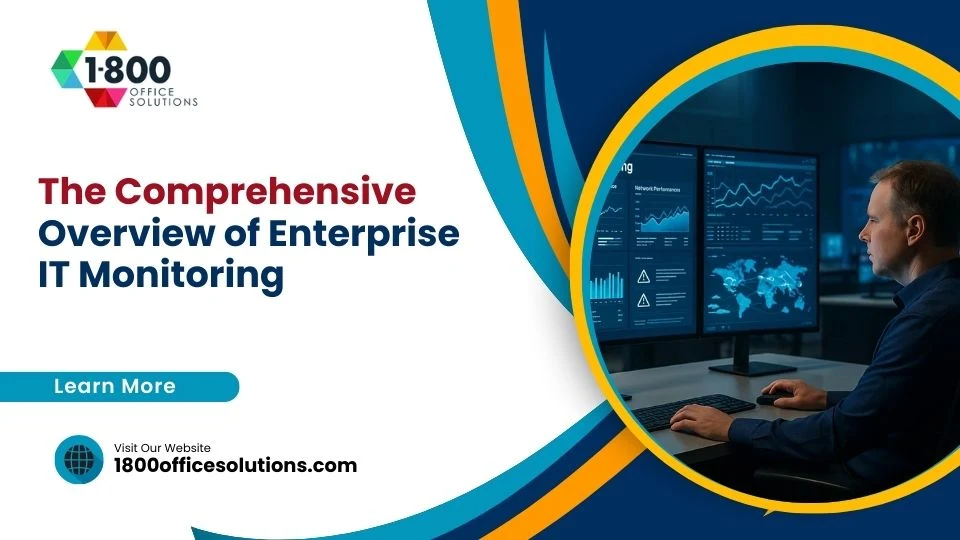Exploring What Is Data Science for Beginners
AI Overview:
Data science stands at the heart of modern innovation, transforming how businesses collect, analyze, and apply information to make smarter decisions. This article from 1-800 Office Solutions, backed by over 40 years of experience in IT services and office equipment management, explains the foundations of data science and its wide-ranging impact across industries such as healthcare, finance, manufacturing, retail, and education.

What Is Data Science? Explore Its Impact on Industries
Do you struggle to understand how data science drives business growth? This post explains the basic principles of data science and reviews its influence on operational practices across industries. Business owners gain clear strategies to connect modern data science with reliable IT services and office equipment management. Drawing on over 40 years of proven performance in leasing all-in-one printers, scanners, copiers, and fax machines as well as repairing office equipment, 1800 Office Solutions offers practical guidance to address everyday technology challenges.
Understand the Core Concepts of Data Science and Its Uses

Data science involves collecting, analyzing, and interpreting data to drive business decisions. Experts apply key techniques such as data analysis and statistical evaluation, using online data science methods. Tools like github support projects, while data visualization methods clearly convey insights, and practical experience strengthens applications across industries.
Define Data Science and Its Key Components for Industries
Data science represents a systematic approach to analyzing and interpreting information by applying principles of mathematics and statistics. This field employs data processing methods that ensure reproducibility and adopts methodologies reminiscent of a master of science program to tackle complex industry challenges.
Industries appreciate the value of data science as it transforms raw information into actionable insights that refine operations. Many organizations use tools such as apache spark to manage large volumes of data processing while maintaining high standards of reproducibility in their analyses.
Identify Major Data Science Techniques and Their Applications
Data science applies advanced methods like regression analysis and probability to convert large amounts of information into practical outcomes. Industry professionals rely on sql queries and data wrangling techniques to structure raw numbers into clear intelligence that supports strategic business decisions.
Expert practitioners use these methods to improve data accuracy and simplify decision-making across organizations. Combining sql operations with systematic data wrangling and precise regression analysis yields accurate probability estimates that drive targeted intelligence for industry applications.
Explore the Importance of Data in Driving Business Decisions
Organizations rely on rigorous data analysis to validate a sound hypothesis and steer strategic planning. By applying advanced methods such as deep learning and cluster analysis, they translate raw data into clear metrics that refine business decisions.
Focused evaluation of data offers business leaders precise insights that streamline operational strategies. This methodical approach, incorporating techniques like deep learning and cluster analysis, empowers decision-makers to adjust processes and achieve measurable improvements.
Highlight Tools Commonly Used in Data Science Projects
Data science professionals use advanced tools that support processes related to exploring data. An interactive dashboard with efficient design simplifies the conversion of raw information into clear, actionable visuals. This approach ensures timely analysis and improved information handling during project assessments.
Institutions such as Harvard University have influenced best practices for these tools. Industry experts rely on machine learning systems to automate workflows and maintain a steady stream of precise results. These applications provide business owners with a practical way to manage large-scale data projects while ensuring reliable performance.
Examine Data Visualization Methods in Conveying Insights
Data visualization methods convert detailed information into accessible visual representations that facilitate immediate insights into operational trends. Such techniques combine rigorous data management practices with machine learning components in a well-designed program that delivers consistent predictive analytics.
Interactive visual tools allow business professionals to recognize emerging patterns and rapidly assess performance metrics. This approach integrates robust data management with advanced machine learning techniques to generate reliable predictive analytics that support strategic decision-making.
Clarify the Role of Statistical Analysis in Data Science
Statistical analysis serves as a core function in data science by converting raw numbers into actionable insights through mathematical techniques applied to data housed in a secure database. Professionals use robust IBM software to build reliable forecasting models that simplify complex information and support sound decision-making.
Online platforms offer specialized training that refines these statistical methods, allowing experts to improve their practical applications continuously. A dedicated community of professionals exchanges actionable insights that drive precise forecasting and streamline data evaluation for industry needs.
Investigate the Impact of Data Science on Various Industries

Data science transforms multiple industries. In health care, prediction models improve patient outcomes using natural language processing and apache hadoop. The internet turns data into actionable intelligence for finance, retail, manufacturing, technology, and education. This section details practical applications across fields, offering insights from medicine to logistics and digital innovation.
Analyze Data Science Applications in Healthcare and Medicine
Data science transforms healthcare by using modern computer systems to process and analyze complex patient data. Hospitals build robust infrastructure with cloud computing platforms that allow each scientist to achieve a clearer understanding of critical health trends.
Medical institutions apply data science to refine diagnostics and tailor treatment plans effectively. Leveraging cloud computing, computer-driven methods, and careful evaluation by a dedicated scientist, these organizations update their infrastructure to boost overall care quality.
Assess How Data Science Enhances Financial Services Efficiency
Data science drives financial institutions toward greater efficiency by processing vast amounts of information into actionable insights that improve decision making. The incorporation of state-of-the-art graphics and modern technology within accurate data structure models supports practical training initiatives, contributing to better financial health.
Advanced analytics allows financial experts to predict risks and detect anomalies, paving the way for efficient expense management and revenue forecasting. This approach supports focused education efforts and refines data structure techniques that supply clear insights for improved operational performance.
Explore Data-Driven Marketing Strategies in Retail Sectors
Retail sectors have adopted data-driven marketing strategies that combine technical analysis with a strong focus on consumer behavior. Retailers integrate linear regression models and mining techniques to uncover trends that guide targeted promotional campaigns.
Experts implement exploratory data analysis to convert raw data into reliable statistics that shape efficient decision-making. This practical approach offers actionable insights that help adjust marketing tactics to meet customer behavior patterns effectively.
Review Data Science Roles in Manufacturing and Logistics
Manufacturing and logistics companies depend on data science roles that use computer programming skills to drive effective problem solving and improve process coordination. These professionals manage a data warehouse that organizes essential production and distribution metrics, contributing to informed decision making and smoother operations.
Industry specialists demonstrate strong leadership by integrating data science online practices for continuous skill development and operational improvement. They apply structured analytical methods to streamline workflows, reduce delays, and support reliable performance in challenging industrial settings.
Study How Technology Companies Utilize Data for Innovation
Technology companies systematically adopt a specialized curriculum to prepare their teams for data-driven innovation. They use advanced software and microsoft excel to process big data, ensuring that clean data supports efficient operational decisions.
Firms streamline workflows by integrating traditional tools with modern software to extract valuable insights from vast data sets. By implementing rigorous practices that maintain clean data, they convert big data into practical outcomes that support ongoing innovation.
Evaluate the Effects of Data Science in the Education Sector
Educational institutions benefit from data science through improved decision-making and streamlined operations. Innovative software that employs a specialized language and regular expression techniques offers a clear user interface, enabling organizations to integrate business intelligence insights into daily academic planning.
Robust methods of data evaluation empower schools to assess performance metrics and adjust curricula accordingly. This practical approach supports educators in using intuitive systems that blend a well-defined language with regular expression capabilities to upgrade their organization’s business intelligence.
Learn About Key Trends Shaping the Future of Data Science

This section outlines the rise of artificial intelligence in data science and highlights the value of big data technologies with robust data model practices. It discusses data privacy regulations, the growing popularity of cloud analytics, examines advancements in machine learning techniques with tensorflow learning, and forecasts future data jobs for finance professionals and engineer roles.
Identify the Rise of Artificial Intelligence in Data Science
Artificial intelligence now drives significant changes in data science practices by optimizing data visualization techniques and using python to automate analysis. Industry professionals integrate this innovation to simplify management tasks while benefiting from structured mentorship that strengthens their technical skills.
Organizations incorporate advanced AI tools to process large data sets and create clear visual insights that support strategic decisions. They value effective mentorship programs that foster practical learning and encourage innovation, thereby enhancing overall management of critical projects.
Understand the Significance of Big Data Technologies
Big data technologies serve a significant role in converting unstructured data into actionable insights. Modern computer science methods equip organizations with the knowledge required to conduct effective research and make informed decisions.
Industry research shows that applying robust big data solutions improves data management across various sectors. This practical use of computer science strengthens science-based approaches that transform unstructured data into clear, valuable information.
Discuss the Impact of Data Privacy Regulations on Practices
Data privacy regulations reshape practices by enforcing strict protocols for handling sensitive information. Organizations adopt trusted programming language solutions and artificial intelligence models to perform compliance checks that yield clear, actionable insights.
These mandates drive a balanced integration of security measures with innovative analysis techniques. Business analysts benefit from using sas platforms to extract refined insights that support secure data processing and reliable decision-making.
Reflect on Cloud Analytics and Its Growing Popularity
Cloud analytics stands as a reliable solution for companies seeking real-time insights to drive efficient decision-making. Organizations integrate cloud analytics tools with data mining and statistical inference methods to support refined business analytics and overcome operational challenges.
Modern enterprises benefit from platforms that simplify access to large data sets while maintaining scalability. Experts observe that using a cloud analytics tool consistently improves data mining efforts and strengthens statistical inference processes, resulting in actionable business analytics outcomes.
Examine Advancements in Machine Learning Techniques
Recent progress in machine learning techniques offers accurate prediction models that support proactive service planning for office equipment leasing and repair. Business outcomes improve when reliable forecasting helps schedule maintenance efficiently across copiers, scanners, and all-in-one printers.
Experts at 1800 Office Solutions apply these advanced models to monitor usage patterns and detect early signs of equipment issues before disruptions occur. This approach refines operational decisions and strengthens managed IT services, ensuring that leased assets perform reliably and cost-effectively.
Predict the Future Landscape of Data Jobs and Skills Needed
Industry experts foresee a shift in data jobs as organizations break new ground in data science applications. The evolving landscape will require professionals to combine technical skills with sound analytical thinking to manage information systems effectively in sectors tied to IT services and office equipment.
Firms will seek individuals skilled in statistical evaluation, machine learning methods, and reliable IT support practices. Those who merge technical expertise with practical business insight are positioned to succeed in technology-based roles that drive operational efficiency.
Understand the Skills Required for a Career in Data Science

Data science careers require expertise in key programming languages, robust mathematical and statistical skills, strong soft skills for effective team collaboration, and deep industry domain knowledge. Certification programs and hands-on internships support career growth. This section outlines these essential areas, equipping professionals with practical insight into the skills needed for success.
List Essential Programming Languages for Data Science Professionals
Data science experts advise that professionals build strong skills with programming languages that support rigorous data analysis and statistical evaluation. A solid background in Python, R, and SQL enables efficient data management and precise reporting in business environments. These languages form the core of applications that assist data professionals in generating clear and actionable insights.
Experienced professionals note that knowledge of high-demand programming languages strengthens the ability to monitor, analyze, and optimize IT systems. Mastery of these languages allows for the development of robust frameworks that support system maintenance and the smooth functioning of office equipment services. This technical proficiency contributes to smarter decision-making and improved operational efficiency across service-driven sectors.
Highlight Important Statistical and Mathematical Knowledge
Statistical evaluation and mathematical accuracy serve as key tools for building models in a data science career. Mastery of regression techniques, probability distributions, and quantitative methods allows professionals to create frameworks that precisely inform business strategies.
Practical experience in applying these skills transforms raw numerical data into actionable insights across industries. This expertise enables professionals to design analytical systems that improve strategic planning and boost operational performance in various business settings.
Discuss Necessary Soft Skills in Data Science Teamwork
Data science teams rely on clear communication and active listening to reach accurate conclusions during complex projects. Professionals work together by sharing insights effectively, a practice that mirrors the operational precision observed in organizations with extensive experience in office equipment leasing and repair.
Team members benefit from empathy and adaptability as they address challenges, ensuring that each contribution supports a unified objective. This approach reflects the disciplined collaboration seen in established service providers, where coordinated efforts lead to practical and reliable outcomes.
Review the Importance of Domain Knowledge in Projects
Domain knowledge allows data science professionals to match analytical techniques with industry-specific challenges. A strong grasp of sector details enables experts to select relevant variables and tailor models that produce clear, actionable insights. This practical understanding strengthens the connection between technical analysis and business requirements.
Seasoned specialists integrate their comprehension of operational processes, such as office equipment leasing and repair, with precise data analysis. This method supports effective decision-making and bolsters systems that underlie managed IT services. Their expertise demonstrates that focused, domain-based insight remains key to constructing data solutions that meet business needs.
Explore Certification Programs for Aspiring Data Scientists
Certification programs for aspiring data scientists offer focused training in data analysis, statistical modeling, and essential programming techniques that support a successful career in data science. These courses include practical projects that mirror real business challenges, enabling learners to apply analytical methods that drive efficient decision-making.
Industry professionals with extensive experience in IT services and office equipment management note that certification courses build a strong foundation in data management and predictive analytics. Drawing on four decades of expertise, established providers recognize that these programs refine technical skills while addressing the operational needs common to managed IT projects.
Consider the Benefits of Practical Experience and Internships
Practical experience through internships offers data science professionals a valuable opportunity to combine theoretical knowledge with hands-on problem solving, mirroring the expertise demonstrated by 1800 Office Solutions in managing office equipment and IT services. Exposure to real-world challenges during internship placements sharpens technical and analytical skills, preparing individuals for rigorous decision-making tasks in data analysis and system maintenance.
An internship creates an environment to practice data science techniques, such as data analysis and machine learning, while also addressing operational demands like those met in office equipment leasing and repair. This training grounds professionals in the practical aspects of a data science career, equipping them to support managed IT services and ensure smooth, efficient operations.
Discover How Businesses Can Implement Data Science Strategies

This section explains steps for integrating data science in business. It details essential resources, a robust data infrastructure and platform, and key performance indicators for tracking success. It also presents case studies on effective initiatives and addresses risks and challenges associated with adopting data-driven strategies.
Outline the Steps to Integrate Data Science Into a Business
Business leaders initiate the integration of data science into a company by defining clear objectives and identifying specific operational challenges that data insights can address, such as optimizing office equipment leasing programs and IT support routines. A thorough assessment of current data collection and analysis practices lays the groundwork for a tailored strategy that aligns with long-established service principles.
The next step involves constructing a secure data framework that enables seamless information flow and real-time analytics, supporting efficient decision-making for equipment repair and service scheduling. Drawing on 40 years of operational experience, experts form dedicated teams to continuously monitor and refine analytical models, which strengthens overall business performance.
Identify Necessary Resources for a Successful Implementation
Successful implementation of data science strategies requires a robust IT infrastructure, reliable analytics tools, and skilled technical teams. Companies with 40 years of experience, such as 1800 Office Solutions, demonstrate how investing in secure data platforms and proficient maintenance personnel can support effective operations in office equipment leasing and repair.
Businesses planning to adopt data science initiatives must allocate resources for advanced software, continual training, and strategic system updates. Drawing on practical expertise from longstanding office equipment operations, these investments help streamline decision-making and ensure that analytics drive efficient management of printed and scanned services.
Discuss the Importance of Data Infrastructure and Platform
A robust data infrastructure forms the backbone of successful data science strategies for businesses managing office equipment leasing and repair operations. It supports secure data flow, accurate analysis, and timely access to performance metrics that drive optimized maintenance and lease scheduling. Experts from 1800 Office Solutions rely on this strong framework to overcome operational challenges and maintain reliable service levels.
A comprehensive platform unifies various data sources and streamlines the integration of analytical tools across operational systems. It converts raw data into actionable insights that help teams schedule maintenance and optimize equipment leasing procedures. This integrated system supports real-time monitoring and guides informed decision-making in managed IT services.
Highlight Key Performance Indicators for Measuring Success
Companies monitor key performance indicators to assess the impact of data science strategies on their operations. Experts often review metrics such as equipment uptime, service response times, and maintenance costs to determine improvements in office equipment leasing and repair services.
Industry professionals set clear benchmarks and regularly evaluate maintenance cycles, repair turnaround, and cost trends to measure success. These assessments guide adjustments in data science practices and support reliable performance in managed IT services and office equipment operations.
Review Case Studies of Effective Data Science Initiatives
A recognized instance in service management shows how a data science initiative can drive operational improvements for businesses dealing with office equipment. A manufacturing firm applied targeted data analysis to schedule maintenance for its printers and copiers, resulting in smoother repair cycles and reduced downtime.
Another project by a business in the managed IT sector demonstrates the practical benefits of integrating data analytics into service operations. By correlating equipment usage details with repair schedules, the initiative provided actionable insights that helped adjust service cycles and cut costs.
Explore Risks and Challenges in Data Science Adoption
Organizations encounter technical and operational obstacles during data science adoption that may disrupt routine IT services and office equipment management. They face issues with data integration and quality control when updating legacy systems to support advanced analytics, making it essential to address compatibility and security concerns early in the process.
Companies also experience strategic challenges due to a shortage of skilled personnel and clear implementation guidelines for data science projects. Business leaders recognize the need for ongoing technical support and detailed planning to mitigate these risks and ensure that analytical efforts align with efficient IT service management and equipment maintenance.
Examine Ethical Considerations in Data Science Practices

Expert review covers ethical concerns in data collection methods, the necessity of consent in data usage, and data bias implications. It emphasizes algorithm transparency and accountability, examines regulatory frameworks, and highlights best practices for responsible data handling. Each topic offers practical insight into ethical standards in data science, guiding businesses toward reliable, transparent practices.
Define Ethical Issues Surrounding Data Collection Methods
Ethical issues in data collection center on the need to protect individual privacy and ensure transparent consent procedures. Organizations sometimes gather information without clearly explaining how it will be used, leading to potential breaches of trust and misuse of sensitive data. Clear policies and rigorous internal controls help maintain industry standards and reinforce stakeholder confidence.
Data collection methods are scrutinized when consent is ambiguous or communication about data usage falls short. Experts recommend establishing straightforward consent protocols and regularly evaluating data handling practices to prevent ethical lapses. Practical examples show that adhering to clear guidelines not only safeguards personal information but also supports reliable analytics across industries.
Assess the Importance of Consent in Data Usage
Obtaining explicit consent when handling data forms a foundation of ethical data science practices. Clear communication about data use helps businesses maintain transparency and build trust with stakeholders while minimizing the risk of misusing sensitive information.
Consent processes that require documented agreement support adherence to data privacy standards and regulatory guidelines. Industry experts note that this approach reduces disputes over data practices and reinforces a reliable framework for managing information securely.
Analyze Biases in Data and Their Implications
Data bias occurs when data collection methods favor certain results, leading to a narrow view that can distort analytical outcomes. Such imbalances may result in misinterpreted patterns that affect strategic planning and operational decisions across industries.
Industry professionals address these challenges by implementing systematic reviews and using transparent reporting practices to reduce bias. Regular analysis of data quality and model adjustments help maintain fairness in analytical outputs while supporting reliable business operations.
Discuss Transparency and Accountability in Algorithms
Transparency in algorithm development requires clear documentation and an open review process that details data sources, processing steps, and decision criteria. This practice allows stakeholders to verify model performance and identify potential areas for improvement, thereby building trust in data science applications.
Accountability in algorithms is maintained through routine audits and comprehensive record-keeping of changes and outcomes. Regular evaluations help organizations pinpoint discrepancies and ensure that analytical models meet ethical standards while supporting reliable decision-making.
Review Regulations and Frameworks Guiding Ethical Data Use
Regulatory standards and established frameworks guide ethical data use by setting clear rules for privacy and security in data science applications. Industry specialists rely on these guidelines to maintain transparency and build confidence in automated data processes.
Ongoing evaluations ensure that policies remain effective and aligned with current best practices. Adherence to these frameworks supports reliable data management and reinforces trust among stakeholders across various industries.
Highlight Best Practices for Responsible Data Handling
Organizations implement responsible data handling by establishing clear protocols for secure data storage and controlled data access. Industry experts in data science maintain robust governance frameworks that use encryption and systematic audits to preserve data integrity and support ethical practices.
Companies provide regular training for technical teams and conduct scheduled reviews of security measures to identify risk factors early. This structured approach enables business leaders to meet regulatory requirements while ensuring that every data science initiative adheres to high ethical standards.
Conclusion
Data science converts raw data into actionable insights that empower organizations to make well-informed decisions across industries. This field improves operational procedures by streamlining equipment management and supporting advanced IT services. Industries such as healthcare, finance, retail, and manufacturing utilize precise statistical evaluations and modern analytical tools to optimize performance and reduce inefficiencies. The continuous integration of robust analytical methods reaffirms data science as a critical resource for achieving operational efficiency and sustainable growth.










